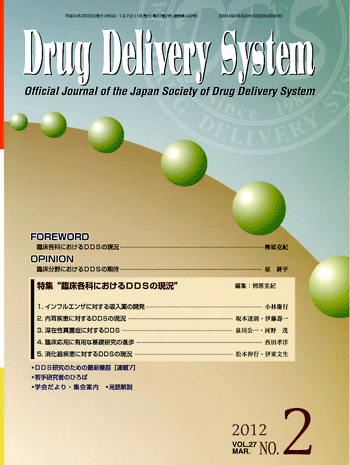All issues

Volume 27 (2012)
- Issue 5 Pages 342-
- Issue 4 Pages 246-
- Issue 3 Pages 156-
- Issue 2 Pages 76-
- Issue 1 Pages 10-
Volume 27, Issue 2
MARCH
Displaying 1-5 of 5 articles from this issue
- |<
- <
- 1
- >
- >|
Feature articles “Current situation of Drug Delivery System in the clinical area” Editor : Katsunori Yanagihara
-
Yoshiyuki Kobayashi2012 Volume 27 Issue 2 Pages 76-87
Published: March 30, 2012
Released on J-STAGE: June 29, 2012
JOURNAL FREE ACCESSLaninamivir octanoate (Inavir®)(1) was discovered as an inhaled anti-influenza drug by Daiichi Sankyo. It was launched for the treatment of influenza in October, 2010. Laninamivir octanoate(1) is the laninamivir(2) derivative with octanoyl moiety at C-9 position, which is a prodrug of laninamivir(2). This acylation to hydroxyl group at C-9 position of laninamivir(2) generated its drastic drug efficacy improvement for the treatment of influenza, and the prodrug shows its interesting drug profile such as "single administration for the treatment of influenza". In this review, I will introduce the discovery story on Laninamivir octanoate(1) and its interesting drug profile.View full abstractDownload PDF (1562K) -
Tatsunori Sakamoto, Juichi Ito2012 Volume 27 Issue 2 Pages 88-92
Published: March 30, 2012
Released on J-STAGE: June 29, 2012
JOURNAL FREE ACCESSTo override the difficulty of the treatment of inner ear disorders, inner ear drug delivery systems have been developed and are tested in clinical trials. Examples of using osmotic pumps, sustained release materials, and new cochlear implant electrodes are presented.View full abstractDownload PDF (389K) -
Koichi Izumikawa, Shigeru Kohno2012 Volume 27 Issue 2 Pages 93-105
Published: March 30, 2012
Released on J-STAGE: June 29, 2012
JOURNAL FREE ACCESSThe number of deep-seated mycosis cases is increasing rapidly along with the extreme advanced technology and highly sophisticated treatment. High mortality of deep-seated mycosis is critical concern, and an appropriate strategy and usage of antifungals is extremely important. The increasing potential efficacy of antifungals using the technology of drug delivery system is one of the reasonable strategies for improving the outcome of these patients with fungal infection. The development of liposomal amphotericin B using liposome is considered as a successful model case of development of newer drugs to improve the potential antifungal activity and reduce the cytotoxic effect using drug delivery system. Other newer antifungal drugs using a variety of drug delivery technology are currently being developed and numerous studies are underway. The main aim of this review is to introduce these developing drugs and the future of management of deep-seated mycosis.View full abstractDownload PDF (1306K) -
Koyo Nishida2012 Volume 27 Issue 2 Pages 106-115
Published: March 30, 2012
Released on J-STAGE: June 29, 2012
JOURNAL FREE ACCESSWhile the development of a new medicine makes little increase, improvement in the efficacy and safety of the existing drug can be achieved by new DDS formation in clinical each subject (respiratory organ, circulatory organ, otolaryngology and infectious disease). The introduction of biomaterial and control of targeting functions is the key to improve the disposition characteristics of a drug in DDS development. On the other hand, revision of the Japanese Pharmacopoeia was performed according to new dosage forms.In this paper, the present condition of the DDS formulation for clinical application was reviewed in clinical each subject and infectious disease. Furthermore, I outlined the basic DDS research supporting the development of new DDS formulation. In particular, I focused on inhalation device, stent, new injection devise and vaccine.View full abstractDownload PDF (601K) -
Nobuyuki Matsumoto, Fumio Ito2012 Volume 27 Issue 2 Pages 116-125
Published: March 30, 2012
Released on J-STAGE: June 29, 2012
JOURNAL FREE ACCESSIn this article, we will discuss several technologies of drug delivery system, which are related to drug induced gastrointestinal mucosal injury, treating inflammatory bowel disease, interferon preparation in treating viral hepatitis, an MRI contrast agent to detect hepatic tumors, and an anti-cancer drug for the treatment of hepatodellular carcinoma.View full abstractDownload PDF (1798K)
- |<
- <
- 1
- >
- >|